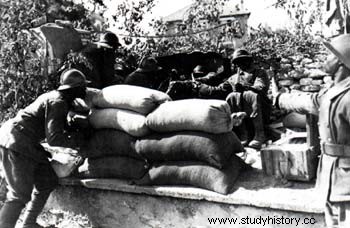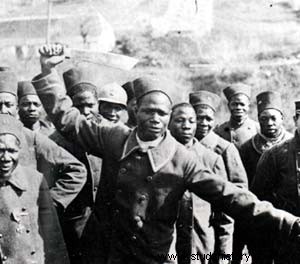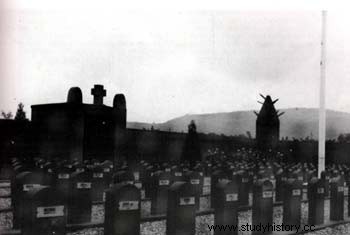From June 15, the last constituted units of the colonial army will be thrown into the battle when it is already lost. Moreover, they are used in dispersed units, such as the 8th D.I.C. which, leaving Montélimar, abandoned one of its regiments, the 25th R.T.S. on the outskirts of Lyon to participate in the defense of the outlet of the Rhone Valley. Engaged near Mantes, it will fight a retreat, around Houdan, then Maintenon.
-

- The sacrifice of the Senegalese
On June 24, near La Haye-Descartes, in front of Châtellerault, the famous R.I.C.M. triggers a counter-attack on the enemy elements trying to cross the Creuse. The Germans are jostled and abandon equipment and many prisoners, stunned and furious
 What's wrong with you? they ask. The war is over! No more shooting!
What's wrong with you? they ask. The war is over! No more shooting!
They attract this superb response:
 The war will be over when you get home!
The war will be over when you get home!
Even if, in the hours that followed, the men of the R.I.C.M. are forced to admit that the armistice is indeed signed, they make this reply a kind of motto. They will know how to remember it, in four years.
Remaining around Lyon, the 25th regiment of Senegalese skirmishers of Colonel Bouriand was split into two elements. A battalion remains on the left bank of the Rhône, assigned to the immediate defense of the city, the other two are distributed to the west, between SaintEtienne and Lyon on the Saint-Germain-au-Mont-d'Or-Chasselay line. Their mission can be summed up in a few words:“To hold on without hindsight. “For the Senegalese, it is a clear, simple order, which there will be no question of. transgress. The 25° R.T.S. is located facing the north, from where the IV" Panzerdivision of the XVI° Armeekorps surges. The Germans now believe in a simple military promenade. The armistice is on the horizon of this last week of the campaign. On June 18, they preparing to overrun Lyon by the right bank of the Rhône. On the 19th, after having passed Anse, they were preparing to make a turning movement which would bring them back to their axis, by Rive-de-Gier. And then they came upon the point of support from Montluzon.
-

- The sacrifice of the Senegalese
The night before, the 25th R.T.S. received the cancellation of the previous order instructing them to "hold out until the end". Part of the workforce fell back to Rive-de-Gier, but there remains a battalion which could not be touched by the message, six hundred men, installed as a point of support in the convent of the Sueurs de Saint-Joseph, of which they have made a real stronghold commanding the outlet of all the axes that it prohibits. The Germans have tanks, cannons, machine guns. The Senegalese have only "86/93" rifles that survived the Great War. One submachine gun per section and no heavy weapons. Never mind, the Senegalese will oppose the armor with their will and their bayonets. The attack begins in the early hours of the morning. The losses are important, on both sides, but the convent remains in the hands of the skirmishers.
-

- The sacrifice of the Senegalese
With cannon shots, the enemy tries to destroy the resistance nests one by one, then goes on the attack. It's another failure. Throughout the day, hand-to-hand combat pitted the Senegalese against successive waves of attackers. To reduce the small battalion, it takes no less than an armored brigade and two panzerpionnier regiments. In the evening, the points of support are surrounded and fall, one after the other.
There is not a single European cadre capable of fighting, nor a single one who can intervene for the benefit of Africans. These are first assembled in front of the wall of the convent and shot with machine guns. Some, mad with terror, try to take refuge inside. the cellars of the convent. They are chased there, shot down with machine guns. To better kill them, their hands were tied with barbed wire. The carnage continues, horrific, ruthless. Disarmed, the skirmishers are hung upside down from the trees of the orchards, others, lined up, lying on the road, are crushed by the tracks of the tanks. Only about twenty of them are spared. They spend the night, standing, chained by wire. They may be hoping for their life to be saved. Vain hope. From the morning, the horror sets in again and, this time, we can no longer speak of exasperation, of excitement due to the fight. The decision taken in their regard was carefully considered. It will be coldly executed. At dawn, an officer detaches thirteen of them. They are taken to Lentilly, where they are ordered to dig their graves. They are then shot by the machine guns of the Panzers. Still hampered, like wild beasts, the survivors are pushed, come what may, to the Lyon suburb of Vaise. There, at the bottom of the Montée de Balmont, they are finished off with shovels and bayonets:they were probably not considered worthy of a bullet in the head.
-

- The sacrifice of the Senegalese
Perhaps the Germans wanted to set an example? They failed, although for several days they prevented the inhabitants from burying the poor remains of these heroes. Less than a year later, in 1941, a commemorative plaque proclaimed:“Here were shot by the Germans twenty Senegalese riflemen for having, the day before, by order, tried to stop an army. »
An army ! What finer tribute could be paid to these skirmishers who, in those tragic days of June 1940, showed the French how obscure Porpoises knew how to die. The following year, on the very day when the Germans invaded the "free" zone, November 8, 1942, a ceremony was organised, not far from the scene of the massacre, in front of a monument, a reconstruction of an African "tata", around from which, finally, the Senegalese had been gathered and decently buried. They were 188.
